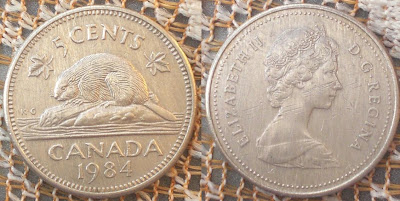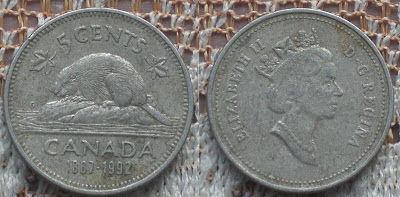1 cent, 2006

The reverse shows the maple leaf, which is widely recognized symbol of Canada.
At the beginning of the eighteenth century, the settlements of New France had attained a population of about 18,000. Also by this time, the maple leaf had been adopted as an emblem by the Canadians along the Saint Lawrence River.
Its popularity with French Canadians continued, and was reinforced when, at the inaugural meeting of the Société Saint-Jean-Baptiste in 1834, the maple leaf was one of numerous emblems proposed to represent the society. Speaking in its favour, Jacques Viger, the first mayor of Montreal, described the maple as "the king of our forest; ... the symbol of the Canadian people."
The Royal Standard of Canada showing a sprig of three maple leaves as part of the design.
The flag of Canada, featuring a stylized maple leaf in the centre.
The maple leaf slowly caught on as a national symbol: in 1868, it was included in the coat of arms of both Ontario and Quebec, and was added to the Canadian coat of arms in 1921. In 1867, Alexander Muir composed the patriotic "The Maple Leaf Forever," which became an unofficial anthem in English-speaking Canada. From 1876 until 1901, the leaf appeared on all Canadian coins, and remained on the penny after 1901. During the First World War, badges of the Canadian Expeditionary Force were often based on a maple leaf design. The use of the maple leaf as a regimental symbol extended back to the 1800s, and Canadian soldiers in the Second Boer War were distinguished by a maple leaf on their sun helmets.
The maple leaf finally became the central national symbol with the introduction of the Canadian flag (designed by George F. G. Stanley) in 1965, which uses a highly-stylized eleven-pointed maple leaf, referring to no specific species of maple.
The obverse shows the queen Elizabeth II, and D.G. Regina on the obverse. D.G. regina stands for die gratia regina, and it means by grace of the god, queen.
5 cents, beaver: 2004

The reverse shows the beaver dividing the denomination and the date,and the obverse shows Elizabeth II.
5 cents, 1984

The five cent coin is also called a nickel. The obverse of this coin shows a young Elizabeth II and the reverse shows a beaver, which divides the denomination and the date.So what exactly is the connection between Canada and the beaver?
One would think with the size and wilderness of Canada that the animal most associated with the country would be the moose, or the bear. But no, it's the quiet, unassuming, hard working beaver...........actually, maybe it's a perfect representation after all...
But, how did the beaver become "the animal of Canada"? Famous enough to grace the Canadian nickel and receive official Canadian emblem status. Truth be told, it is a sordid story beginning with greed and death in the 1600's.
Europeans travelled to Canadian shores, and instead of the spices they had hoped to find, they discovered a country teaming with busy little beavers. Not a big deal except, fur hats were becoming all the rage. As the popularity for beaver chapeau's grew, the European population of beavers declined. As a result, the exploration of Canada was largely due to the furry little creature with the flat tail.
France's King Henry IV thought beavers were a great way earn an income while building a new empire on Canadian shores. The Hudson's Bay Company, Canada's oldest and longest running business made so much money from the fur industry that they added four beavers to their coat of arms in 1678. A coin was developed around the same time that was equal in value to one beaver pelt.
The reason beaver fur was so sought after for hat making is because the fur has little barbs on the end of each hair; when pressed together they become like felt and is probably what keeps the beaver dry and warm while swimming.
By the mid-19th century the beaver had almost been trapped into extinction - it was estimated that Canada was home to six million of Canada's largest rodents prior to the fur hat fashion season. When the demand for beaver pelts was at its highest, 100,000 pelts per year were being shipped to Europe. Fortunately for Canadians - and the beaver - fashions change; eventually beaver was out and silk was in.
5 cents, 1992: 125th anniversary of confederation

Canada was under British rule from 1764 to 1867. 1992 was Canada's 125th anniversary of confederation, and commemorative coins like this one were issued to celebrate the occasion.
10 cent, yacht : 2008

The reverse shows the country, date, denomination and a yacht. Probably yachting is a popular sport in Canada as it has a long coastline. The Northern coastline would be frozen throughout the year and the Eastern coastline should be thawn in the summers, making it ideal for yachting.
25 cent, moose: 1975

The reverse shows a moose, value and date. The moose is the largest species of deer, and is found in all parts of Canada and Alaska. Obverse shows Elizabeth II.




well colection !!!!
ReplyDeleteKulraj,
ReplyDeleteThat's not a moose on the Canadian 25-cent coin -- it's a barren ground caribou. Some of the caribou herds in the Canadian arctic number in the millions; they've long been a symbol of the wild nature of Canada's north. Moose are a totally different animal.
The yacht is actually a fishing schooner. The portrait was modeled after a famous Canadian schooner named "Bluenose", which achieved international fame as a racing schooner in the 1920s and 1930s.
Both coins' reverses were designed by a Canadian sculptor named Emanuel Hahn. Interestingly, Hahn originally intended the Bluenose to go on the 25-cent coin, but the folks at the Royal Canadian mint decided to put the ship on the 10-cent coin instead.
The maple leafs on the 1-cent and the beaver on the 5-cent coins were designed by an Englishman, George Kruger-Gray.
Cheers,
Thanks for the input friend.
ReplyDeleteI would have liked it better if you had put your name with the comment.
I have one cent alizabeath 11 coin 1993.contect me.
ReplyDelete